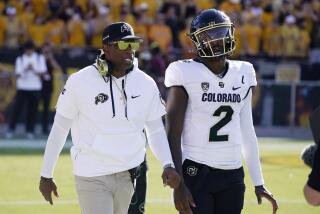Chinese Professor Looks to U.S. to Help Him Fulfill Hoop Dreams
- Share via
BEIJING — Gong Peishan, a deceptively unassuming academic, is actively gathering information from the United States to help the People’s Republic of China.
He took a fact-finding trip to the U.S. and met with high-ranking specialists in his field. He made careful note of the events and information to which he was given special access. Back in his native land, the bespectacled professor is putting what he learned into practice on behalf of the world’s biggest Communist dictatorship.
But Gong, 70, isn’t trying to launch nuclear missiles with his newfound knowledge. He’s out to launch a social, educational and recreational movement across China, one that could have significant consequences for this nation of 1.2 billion people. Gong’s grand obsession is to reform Chinese college basketball along American lines and propel it into the modern age.
Ambitions Inspired by the NCAA
The organization Gong founded in 1997, the China University Basketball Assn. (CUBA), is a close copy of the National Collegiate Athletic Assn. Last year, CUBA held its first national tournament, complete with its own version of the Final Four, and is planning a second competition this fall.
In addition, the organization hopes to recruit coaches, train referees, host clinics, spot talent in high school, turn universities into player pools for China’s professional leagues and, ultimately, build the same kind of following--spectators, sponsors, you name it--that the NCAA commands.
But more is at stake than just raising the quality of play in China, where Michael Jordan is a household name and an estimated 120 million people shoot baskets in their spare time. If Gong’s hoop dreams come true, then CUBA may alter the way the Chinese play sports and educate their youth.
For decades, China has followed the old Soviet model of athletic development by selecting promising youngsters from childhood and pressing them into a life of rigorous state-sponsored training and competition. The system has produced world-class gymnasts, divers and pingpong players, but forces young athletes to choose between developing their minds and their bodies.
Now, as China moves away from its Marxist past in favor of the free market, other Soviet-era trappings, like the Stalinist approach to sports training, are withering too.
With Chinese parents restricted by state policy to having just one child, fewer are willing to send their only son or daughter off to play sports at the expense of a full education, a growing necessity in the job market.
Gong wants to abolish the traditional separation between education and high-level sports by bringing the two together on China’s 1,040 college campuses. At present, universities boast only lackluster sports teams. They consist of lower-skilled players who have received none of the intensive training provided at state-run athletic academies.
“I can sum up my efforts using our slogan,” Gong said of CUBA’s goals, and he recited the words: “As a young person, I dream of going to college and I dream of becoming a professional athlete. CUBA lets me fulfill my dreams.”
Gong’s direct inspiration is the NCAA, the body founded in 1906 that governs U.S. college athletics. Last year, Gong traveled across the Pacific with other Chinese basketball enthusiasts, met with NCAA officials, studied their system of management and tournament organization, and scored tickets to the 1998 Final Four.
The 16-day trip, financed by a Chinese entrepreneur who has hooked up with CUBA in the first major commercial sponsorship of college athletics in China, was heaven for Gong.
“Since I’ve been engaged with basketball nearly my whole life, it’s been my dream to go to the U.S. to check out the situation there,” said Gong, a former physical education teacher at People’s University in Beijing. “I saw the American method of doing things with my own eyes, and I learned a lot.”
Gong’s knowledge helped CUBA refine plans for its big tournament last fall, a contest that attracted 617 men’s and women’s college basketball teams from throughout China. The competition’s final rounds were broadcast on national television, complete with cheerleaders, commentators, a theme song written by a pop star, and screaming spectators. Tickets cost just $1.25; scalpers got $6.25.
The next step, organizers say, is to establish basketball centers throughout China as training grounds for teenagers and as resources for the wider community.
Ten centers are being set up, from Chengdu in the heartland to Qingdao on the eastern coast. The center here, based at Beijing University, has started running weekend clinics for talented boys and girls able to pay a small fee.
Gong and his volunteer staff of three, who operate out of a two-room office adorned with Chicago Bulls posters, envisage at least 40 more centers to satisfy the demand for high-quality basketball.
Indeed, the popularity of basketball--which arrived in China in 1895, just four years after the game’s invention in the U.S.--is probably outstripped only by pingpong and, perhaps, soccer.
Pro basketball players nail down hefty salaries and enjoy wide recognition, despite a level of play that one outsider rated as equivalent to Division 2 college ball in the U.S. One professional player, Ma Jian, who nearly made the cut for the L.A. Clippers a few years ago, reportedly earns the equivalent of about $120,000 a year, a staggering sum by Chinese standards.
But the fame and fortune is not without its own cost. Wang Zhizhi, who started training at a Beijing sports academy at age 7, barely completed junior-high-level studies before a professional team drafted him at age 14 because of his impressive height. At 6 feet 11 inches, Wang now plays center for the top-ranked August 1 professional team, sponsored by the People’s Liberation Army. “I know I’m less educated than other young people my age,” Wang, 22, said in an interview. “So I hope I can go back to school if there is an opportunity.”
To prevent the sacrifice of education, more parents are shunning the route that Wang took, preferring to keep their children in mainstream schools even if they show athletic talent. They fear their children will have nothing to fall back on later in life or if a sports career fails to materialize.
This has fueled a drop in the number of youngsters enrolled in the sports academies that used to churn out China’s athletes.
“I don’t want her to go to an amateur athletics school,” said Yan Sheng, a teacher in Hunan province whose teenage daughter has shown a knack for shooting hoops. “After professional athletes retire, if they want to work, they encounter a lot of problems because of their lack of schooling.”
Likewise, Zhang Le, a senior at Beijing’s prestigious Qinghua University--the first Chinese college to start up basketball on campus, in 1908--passed up a chance at a pro career. “I thought my education would be interrupted, and I didn’t want that,” said Zhang, 21, a 6-foot-7-inch varsity center.
The Qinghua squad ranks among Beijing’s top three, but a recent afternoon session, during which the players often fumbled the ball or missed fairly simple shots, showed how far Chinese basketball must go to catch up to world-class standards.
Enthusiasts agree that a lack of decent coaching is partly responsible for the low level of play among college and professional teams alike, as is the government’s emphasis on high-quality training for individual sports, such as track and field, to increase China’s chances of winning medals at international competitions.
Sports experts here and abroad do not believe that the old Soviet system of training athletes will disappear immediately. But CUBA’s organizers hope they can gradually fill the gap between education and high-level sports by strengthening extracurricular athletics at Chinese universities.
“It’s a first crack at creating a setup in which young people can exercise athletic talents without being deprived of a real education,” said Judy Polumbaum, a University of Iowa professor who is studying the Chinese sports system.
Big Hopes, Small Budget
CUBA’s efforts are backed by China’s Communist regime, which has scaled back its funding of sports academies as it struggles to balance its budget.
But the support is only moral, forcing the organization to scrounge up resources by charging dues to its member universities. The association’s yearly cash flow adds up to a paltry $1,210, making lack of money the organization’s toughest obstacle, Gong said.
Its biggest benefactor so far is Zhang Ningfei, a garment factory owner from Hangzhou. Zhang, a former player for Zhejiang University, donated the uniforms for last year’s Chinese Final Four teams and spends nearly a third of his time campaigning for CUBA.
Last year, the Italian sportswear company FILA donated about 500 uniforms and 300 pairs of sneakers.
CUBA will not accept money from tobacco or liquor companies, which forced Gong to decline offers from at least two U.S. cigarette manufacturers. “”I can’t forget my responsibilities simply when I see money,” he explained.
So his association soldiers on, relying on the largess of others to keep its agenda of physical and academic education alive.
“Although our organization is very small, our duties and responsibilities are very big,” Gong said. “CUBA is a great cause.”
More to Read
Go beyond the scoreboard
Get the latest on L.A.'s teams in the daily Sports Report newsletter.
You may occasionally receive promotional content from the Los Angeles Times.











